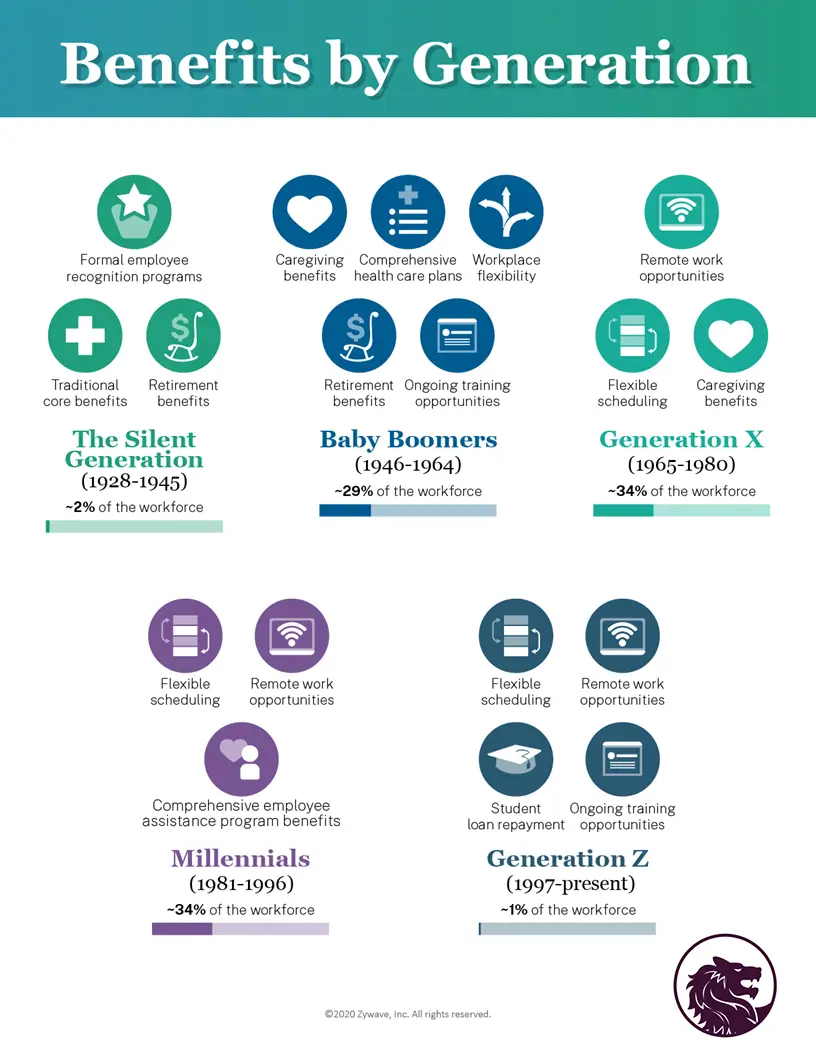
03 Mar Baby boomers vs. millennials: the Employee Benefits they value!
A person’s age influences many of their characteristics over time—their hair color, their muscle mass and, crucially, their preferred benefits. If employers want to provide benefits that their employees will actually use, they must take their varying preferences into account. In fact, one of the biggest challenges for employers is finding benefits that work well for employees of all generations. For instance, a benefit valued by millennials might not be useful for a baby boomer.
For instance, younger employees might want more workplace flexibility and voluntary benefits, whereas older employees may be more interested in retirement benefits and health coverage. It can be overwhelming trying to find a single benefits offering that speaks to all age groups.
Instead, employers should focus on offering a select number of benefits that align with their various employees’ values. Consider the generations represented within the organization and think about what each is interested in. To better handle this task, employers must first understand each generation and its values.
The Silent Generation (1928-1945)
This generation came of age during World War II, a time of great austerity and discipline. Many of these individuals come from nuclear families and have worked for the same employer for decades, making them very loyal. However, many have left or are planning to leave the workforce in the coming years.
Key characteristics: Disciplined | Loyal workers | Eyeing retirement
Workforce composition: ~2%
Preferred benefits: Formal employee recognition programs | Traditional core benefits | Retirement benefits
Baby Boomers (1946-1964)
This generation is often referred to as “the hardest-working generation,” implying their work-life balances may be skewed more toward work. Baby boomers were hit hard by the 2008 recession, and many are stuck working longer in life than they anticipated. This generation is also caring for their aging family members, further extending the retirement goal posts.
Key characteristics: Hardworking | Limited transferable skills| Nearing retirement
Workforce composition: ~29%
Preferred benefits: Caregiving benefits | Comprehensive health care plans | Workplace flexibility | Retirement benefits | Ongoing training opportunities
Generation X (1965-1980)
This generation is more tech savvy than previous generations, having been the first adopters of new technology in the ‘90s. Unlike their predecessors, Generation X doesn’t prize work as much as they do a strong work-life balance. This generation is sometimes called the “sandwich generation” due to their care responsibilities for both younger and older family members. It’s these responsibilities that may indicate why the ideal work-life balance for a Gen Xer skews more toward “life.”
Key characteristics: Tech savvy | Family-oriented | Prizes flexibility
Workforce composition: ~34%
Preferred benefits: Remote work opportunities | Flexible scheduling | Caregiving benefits
Millennials (1981-1996)
This generation will comprise the majority of the workforce in a few short years. These individuals came of age during the dot-com boom and grew up alongside the internet, making them very tech savvy. Millennials saw their parents struggle with the 2008 recession and many now struggle with their own student loans. These financial burdens disillusioned many from the daily nine-to-five grind, causing them to favor workplace flexibility and a healthier work-life balance.
Key characteristics: Goal-oriented | Highly-educated | Values autonomy
Workforce composition: ~34%
Preferred benefits: Flexible scheduling | Remote work opportunities | Student loan repayment | Ongoing training opportunities
Generation Z (1997-present)
This generation, like Millennials, is concerned with financial stability at the cost of one’s health. Gen Zers have seen previous generations struggle to make ends meet despite putting in hard work, as in the cases of outrageous student loans and financial recessions. This makes Generation Z more well-being oriented than other generations, expecting mental health and similar workplace benefits to offset workplace stressors. Additionally, this generation never knew life before the internet, making them quick learners when it comes to technology.
Key characteristics: Well-being oriented | Entrepreneurial | Fast learners
Workforce composition: ~1%
Preferred benefits: Flexible scheduling | Remote work opportunities | Comprehensive employee assistance program benefits
Data sources: Bentley University and the Pew Research Center




Sorry, the comment form is closed at this time.